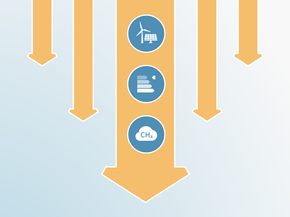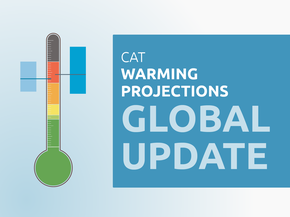Targets
Target Overview
Australia’s NDC targets a 2030 emissions reduction of 43% below 2005 levels. The CAT excludes emissions from land use, land use change and forestry from this target, resulting in 413 MtCO2e in 2030 excluding LULUCF. The CAT rates this target as “Insufficient” compared to both modelled domestic pathways and its fair share of global efforts.
Australia is preparing a new Net Zero Plan as an update to its current Long-Term Strategy (LTS). Its current long-term emissions reduction plan for achieving net zero emissions by 2050, submitted to the UNFCCC as an LTS, was published in October 2021. The current strategy only reduces emissions by 60% below 2005 levels, excluding LULUCF and offsets.
| AUSTRALIA – Main climate targets |
|---|
| 2030 NDC target | |||
|---|---|---|---|
| Formulation of target in NDC |
43% below 2005 levels by 2030 (including LULUCF) (Implemented as an absolute target for 2030, and as an emissions budget covering the period 2021–2030) |
||
| Absolute emissions level in 2030 excl. LULUCF |
413 MtCO2e by 2030 [6% below 1990] [23% below 2005] [25% below 2010] Note: The effect of the 2030 NDC target on gross emissions (emissions excluding LULUCF) is recalculated each year with the revision of historical emissions and projected LULUCF sequestration. |
||
| Status | Submitted on 16 June 2022 | ||
| Net zero & other long-term targets | |||
|---|---|---|---|
| Formulation of target |
Australia aims to reach net zero by 2050 Australia’s Long-term Emissions Reduction Plan indicates it plans to rely on international and domestic offsets for 10% of reductions required to reach net zero by 2050. The reference to domestic offsets means land based carbon sequestration. |
||
|
Absolute emissions level in 2050 excl. LULUCF and international credits |
215 MtCO2e/yr [51% below 1990] [60% below 2005] [61% below 2010] |
||
| Status | Submitted on 29 October 2021 | ||
NDC Updates
Australia submitted a stronger 2030 target to the UNFCCC in June 2022 (Australian Government, 2022) after it had resubmitted its 2016 target in the 2021 round of updates around the Glasgow COP. The target of 2022 is a 43% reduction of greenhouse gas emissions by 2030 below 2005 levels, including LULUCF.
The target will be implemented as both an absolute target and an emissions budget for the period 2021–2030. The 2022 NDC reaffirms Australia’s target to achieve net zero emissions by 2050. The objective has been enshrined into law by the Climate Change Act adopted in 2022.
The NDC also indicates it will make adjustments for “internationally transferred mitigation outcomes” in line with Article 6 of the Paris Agreement, indicating it is also open to using international carbon credits. At present, the detailed rules and quality standards for making use of Article 6 as an ambition raising mechanism are still pending, making it difficult to assess whether they can offer a meaningful contribution to emissions reductions.
Regardless, Australia should first improve its NDC target and climate finance contributions to align with a 1.5℃ Paris Agreement compatible pathway and focus on reducing its domestic emissions, instead of relying on international carbon credits to meet its climate targets.
| AUSTRALIA – History of 2030 NDC updates | First NDC 2016 | 2021 NDC update | 2022 NDC update |
|---|---|---|---|
| 1.5°C compatible |
|
|
|
| Stronger target | N/A |
|
|
| Fixed/absolute target |
|
|
|
Comparison 2030 NDC Targets
| AUSTRALIA | First NDC 2016 | 2021 NDC update | 2022 NDC update |
|---|---|---|---|
| Formulation of target in NDC |
26–28% below 2005 levels by 2030 including LULUCF Implemented as an emissions budget for 2021–2030. |
26–28% below 2005 levels by 2030 including LULUCF Implemented as an emissions budget for 2021–2030. |
43% below 2005 levels by 2030 including LULUCF Implemented as both a target for 2030 and an emissions budget for 2021–2030. |
| Absolute emissions level [excl. LULUCF] | 504–517 MtCO2e in 2030 | Unchanged | 413 MtCO2e in 2030 |
|
Emissions compared to 1990 and 2010 [excl. LULUCF] |
14–17% above 1990 levels by 2030 4–6% below 2005 levels by 2030 6–8% below 2010 levels by 2030 |
Unchanged |
6% below 1990 levels by 2030 23% below 2005 levels by 2030 25% below 2010 levels by 2030 |
| CAT rating |
Overall rating*: Highly Insufficient |
NDC target against modelled domestic pathways: Insufficient NDC target against fair share: Highly insufficient |
NDC target against modelled domestic pathways: Insufficient NDC target against fair share: Insufficient |
| Sector coverage | Economy-wide | Economy-wide | Economy-wide |
| Separate target for LULUCF | No | No | No |
| Gas coverage | All greenhouse gases | All greenhouse gases | All greenhouse gases |
| Target type | Absolute emissions reduction (multi-year emissions budget) | Absolute emissions reduction (multi-year emissions budget) | Absolute emissions reduction (point target from a base year and multi-year emissions budget) |
* Before September 2021, all CAT ratings were based exclusively on fair share and only assessed a country’s target
Target development timeline & previous CAT analysis
CAT rating of targets
The CAT rates NDC targets against each country’s fair share contribution to global climate change mitigation, considering a range of equity principles including responsibility, capability, and equality. The CAT also rates NDC targets against indicative national emissions from global least-cost emissions pathways (called modelled domestic pathways). For assessing targets against the fair share, we consider both a country’s domestic emission reductions and any emissions it supports abroad through the use of market mechanisms or other ways of support, as relevant.
Australia does not intend to use market mechanisms and will achieve its NDC target through domestic action alone. We rate its NDC target against both global domestic pathways and fairness metrics.
The CAT continues to rate Australia’s 2030 NDC target as “Insufficient” when compared to modelled domestic emissions pathways. Australia’s NDC targets emissions 43% below 2005 levels by 2030, including LULUCF.
Although Australia’s NDC lands right at the lower end of the “Insufficient” range, the quantification of its target is impacted by continuous recalculations of LULUCF sinks estimates for 2030. The government projections of these sinks have systematically increased year-on-year, thereby reducing the amount of action Australia needs to take on reducing fossil fuels and emissions in other sectors to meet the NDC target. Given the current changes in climate it is not a given that the land sector will actually act as such a large sink in the future.
A 2030 NDC target in line with 1.5°C compatible modelled domestic pathways for Australia would require emissions reductions of 41% below 2005 levels by 2030 excluding LULUCF, and 60% when including LULUCF.
Australia has yet to submit a 2035 target. For 1.5°C compatibility, Australia would need to reduce emissions 57% below 2005 levels by 2035 excluding LULUCF, and 76% when including LULUCF.
Projections for LULUCF sequestration in 2030 increased fourfold between the government’s 2021 and 2024 projections. This effectively reduces the emissions reduction task for energy, industry, agriculture and waste.
The “Insufficient” rating indicates that Australia’s NDC target in 2030 needs substantial improvements to be consistent with modelled domestic pathways limiting warming to 1.5°C. If all countries were to follow Australia’s approach, warming would reach over 2°C and up to 3°C.
The CAT rates Australia’s 2030 NDC target as “Insufficient” when compared to its fair share emissions allocation. The “Insufficient” rating indicates that Australia’s NDC target in 2030 needs substantial improvements to be consistent with its fair share of the global mitigation effort to limit warming to 1.5°C.
Australia’s target is at the least stringent end of what would be a fair share of global effort, and is not consistent with the 1.5°C limit, unless other countries make much deeper reductions and comparably greater effort. If all countries were to follow Australia’s approach, warming would reach over 2°C and up to 3°C.
Australia needs to improve its fair share contribution through both strengthened domestic emissions reductions as well as financing additional climate action in developing countries.

Australia’s international public climate finance contributions are rated "Critically insufficient." Australia has committed to increase its climate finance but contributions to date have been very low compared to its fair share. To improve its rating, Australia needs to increase the level of its international climate finance.
Australia has pledged AUD 3bn towards climate finance, encompassing both mitigation and adaptation, for the 2020–2025 period. This amount represents an increase from an earlier commitment of AUD 2bn (Department of Foreign Affairs, 2023). However, concerns remain that this commitment will include the relabelling of existing funds (Oxfam, 2023). The government finally rejoined the Green Climate Fund in 2023, after withdrawing in 2019, albeit with a “modest contribution” of AUD 50 million (ABC, 2023; Minister for Foreign Affairs & Minister for Climate Change and Energy, 2023b).
At COP28, Australia joined the Clean Energy Transition Partnership, pledging to end direct public investments into international fossil fuels projects within a year (Minister for Foreign Affairs & Minister for Climate Change and Energy, 2023a). This led the CAT to improve Australia’s fossil fuel finance overseas rating from “Highly Insufficient” to “Insufficient”. However, this does not improve Australia’s overall climate finance rating. To receive a better rating, Australia must increase the level of its international climate finance.
Australia's lack of action on climate finance is central to the discussions around COP31. Australia is proposing to host the 2026 Conference of Parties in collaboration with 'the Pacific family'. In March 2023, governments from Vanuatu, Tuvalu, Tonga, Fiji, Niue, and the Solomon Islands issued the Port Vila Resolution. The resolution calls for more public and private funding to facilitate a fair transition away from fossil fuels and a reform of the global climate finance framework (Australia Institute, 2023).
Net zero and the other long-term target(s)
We evaluate the net zero target as "Poor."
An updated Net Zero Plan is under development by the government but is yet to be published. Australia’s current long-term emissions reduction plan, also submitted to the UNFCCC as a Long-Term Strategy (LTS), was published in 2021. The LTS sets a net zero emissions target for 2050. Yet the strategy presents scenarios which only reduces emissions by 60% below 2005 excluding LULUCF, leaving large residual emissions to be compensated for by assumed land sequestration of carbon, other CDR, or the acquisition of international offset units. It does not introduce any new policies, and relies on global technology trends, carbon offsets and further unknown technology “breakthroughs”.
There are also no plans in the document to phase out coal, curb fossil fuel exports, nor to hold heavy polluters accountable. The government legislated its net zero and 2030 targets in September 2022.
It is still possible for Australia to get emissions onto a pathway to limit global warming to 1.5℃ this century, but urgent action is required. The full net zero target analysis can be found here.
Further analysis
Latest publications
Stay informed
Subscribe to our newsletter




